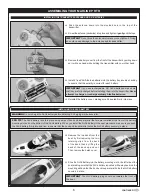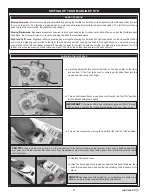
0
GETTING READY TO RuN YOuR MARLIN EP RTR
CHARGING THE NI-CD BATTERY
Do not charge the Ni-Cd battery for more than 9-/2 hours or damage to the Ni-Cd battery can occur.
❑
Plug the Ni-Cd battery charger into an AC wall outlet socket.
NEvER RUN THE NI-CD BATTERY DOWN SO LOW THAT THE MOTOR STOPS WHILE THE BOAT
IS IN AN INACCESSIBLE AREA (LIKE IN THE MIDDLE OF THE LAKE). ALWAYS ALLOW ENOUGH
RESERvE POWER TO RETURN TO SHORE, THEN RUN THE NI-CD BATTERY DOWN UNTIL THE
MOTOR STOPS.
●
Always remove the Ni-Cd battery from the boat when charging it.
●
Always allow the Ni-Cd battery to cool before recharging it.
●
If the Ni-Cd battery gets hot during the charging process, remove it from the charger immediately.
●
Charge the Ni-Cd battery in a well-ventilated area, away from any combustibles.
●
Do not charge the Ni-Cd battery for any longer than 9-/2 hours.
●
Never leave the Ni-Cd battery unattended during the charging process.
IMPORTANT
Before charging the Ni-Cd battery, it must be fully discharged. Discharge the Ni-Cd battery by running the motor
until it stops. This will ensure that you don't overcharge the Ni-Cd battery.
IMPORTANT
As a safety feature, the connectors can only be plugged
in one way.
❑
Plug the battery connector on the Ni-Cd battery into the battery connector
on the charger.
❑
Allow the Ni-Cd battery to charge for 8-/2 to 9 hours. For reference, the
Ni-Cd battery capacity is 800mAH and the charger charges at 200mA
per hour. 800 / 200 = 9 hours.
NI-CD BATTERY CHARGING WARNINGS
After getting out to the lake, but before running your boat for the first time, you must range test the radio control system. This will
ensure that the transmitter is "talking" correctly to the receiver. You should follow this procedure before you run your boat for the first
time and after you have a hard crash, or after a repair.
❑
Turn on the transmitter, then turn on the receiver. Place the boat on its stand on the shore and extend the transmitter antenna
completely. Move the control sticks on the transmitter several times to check the controls. They should operate smoothly.
❑
Walk approximately 75 feet (25 metres) from the boat and move the control sticks on the transmitter once more. Check to make
sure that the controls are operating smoothly at this distance. If the controls work normally, the boat has passed its range
check and it's okay to use.
RANGE TESTING THE RADIO CONTROL SYSTEM
WARNING
If the radio control system does not range check, don't run your boat! Please refer to the troubleshooting guide on
page 2.
●
Double-check that the Ni-Cd battery is fully charged and that the transmitter has fresh batteries installed. When the transmitter is
turned on, both the red and the green LEDs should light up.
●
The Ni-Cd battery should be charged and/or "topped-up" shortly before use. The Ni-Cd battery will lose some of its charge over
time, so don't charge the Ni-Cd battery the day before, then expect it to produce full power when you're ready to use it.
●
Double-check all fasteners to ensure that they're tight, then double-check that the throttle trim lever is centred and that the rudder
is straight.
THINGS TO DOuBLE-CHECk BEFORE uSE






























